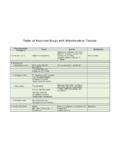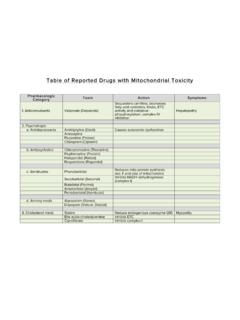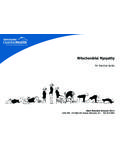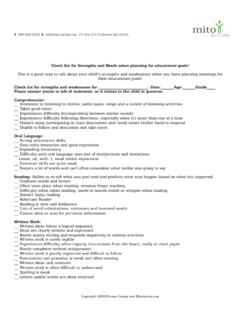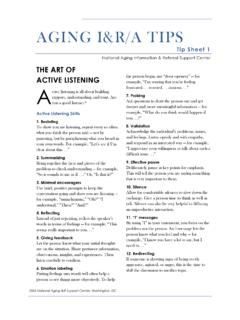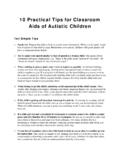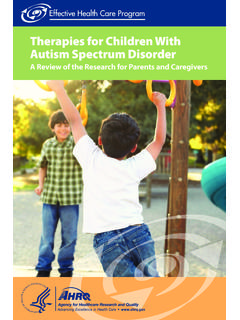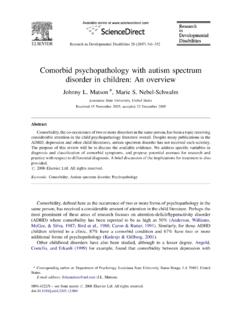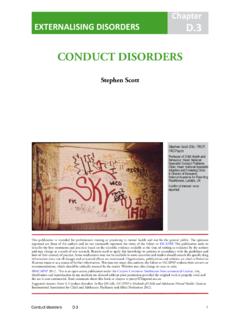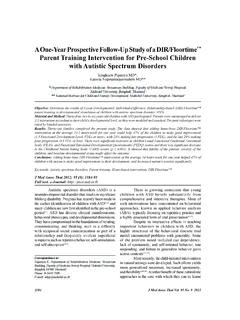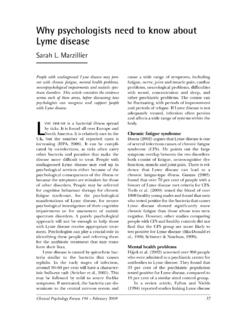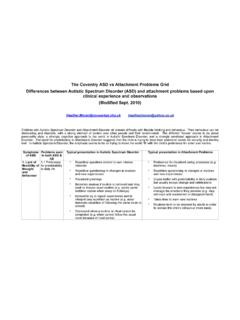Transcription of THE JOURNEY FROM ASD TO A MITOCHONDRIAL DISEASE …
1 THE JOURNEY FROM ASD TO A MITOCHONDRIAL DISEASE diagnosis : Symptoms, testing, treatments & responses to a MITOCHONDRIAL cocktail Families Stories Part IIBy Alyssa DaviAAs discussed in part I of this series, there is an overlapping cohort of children who exhibit ASD symptoms and who have underlying MITOCHONDRIAL DISEASE . Disorders of energy production or defects of oxidative phosphorylation are emerging as a new category of ASD and are being called many di!erent names, including OXPHOS ( MITOCHONDRIAL oxidative phosphorylation), MITOCHONDRIAL complex I de"ciency, and autism secondary to MITOCHONDRIAL DISEASE (AMD).Many of the leading MITOCHONDRIAL specialists (neurologists and geneticists) now acknowledge that there is a group of ASD children whose labs and symptoms are suggestive of MITOCHONDRIAL DISEASE .
2 This is important because a few years ago many specialists did not think this was possible. It is worth noting that that one day was devoted to discussing this link as well as to MITOCHONDRIAL research and treatments at the 2010 United MITOCHONDRIAL DISEASE (UMDF) Symposium in Arizona. In this article, I "rst provide some background information about MITOCHONDRIAL DISEASE and explain what goes in a mito cocktail (a therapeutic combination of supplements and medications), and then I discuss several children s developmental pro"les. The "rst two children received their ASD label "rst but are now diagnosed with MITOCHONDRIAL DISEASE , presumed complex I. I identify these children s symptoms, testing, suggestive lab work, treatments, and responses to the mito cocktail.
3 Then, I give details of another child trying the mito cocktail including their symptoms and responses to the cocktail. y biomedicalIdentifying MITOCHONDRIAL DiseaseMitochondrial DISEASE should be considered when a child has more than 3 organ systems with problems. MITOCHONDRIAL symptoms in ASD children may include:1. abnormal fatigue /exercise intolerance2. developmental stagnation or regression after a viral illness, fever, or vaccine3. regression following surgery, sedation, or anesthesia4. poor muscle tone, muscle weakness, or motor incoordination5. an episode of sudden ataxia (a sudden motor regression at a later age)6. di#culty handling temperature changes (heat or cold), suggesting autonomic temperature control issues7. unexplained GI issues (not related to an allergy)The MITOCHONDRIAL Medicine Society lists the following as metabolic screening labs for MITOCHONDRIAL DISEASE :Basic chemistriesLiver enzymes and ammoniaComplete blood countCreatine kinaseBlood lactate and pyruvateQualitative plasma amino acidsQuantitative urinary organic acidsPlasma acylcarnitine pro"leAlyssa Davi is a former special education teacher and is involved the nonpro"t organization Parents Ending America s Childhood Epidemic (PEACE), which is sponsoring the parent outreach project Epidemic Answers.
4 Please visit or you can contact Alyssa at I: Has Your Child with Autistic Symptoms Been Properly Screened for a Subset of MITOCHONDRIAL DISEASE Known as OXPHOS? ..Probably Not.)Above top: Will, summer 2010 Next page, top: autonomic temperature control problemsbiomedical yMitochondrial DISEASE should be considered when a child has more than 3 organ systems with problems. Amino Acids (plasma/CSF) Organic Acids (urine) Acylcarnitines (plasma) Elevated alanine Elevated TCA intermediates Low free carnitine Alanine/Lysine ratio > 3 Elevated Ethylmalonate Elevated acyl:free carnitine ratio Elevated glycine, Elevated Elevations suggesting proline, tyrosine, or 3-methysglutaconate disrupted fatty sarcosine acid oxidationFindings Suggestive of MITOCHONDRIAL DysfunctionThe MITOCHONDRIAL Medicine Society lists the following lab results as suggesting MITOCHONDRIAL dysfunction:The mito cocktailThe treatment for disorders of energy production is a mito cocktail aimed at increasing cellular energy production and reducing oxidative stress, which in turn reduces reactive oxygen species (ROS).
5 A top MITOCHONDRIAL specialist at the 2010 United MITOCHONDRIAL DISEASE Symposium has listed the following as a possible starting mito cocktail. Many ASD children with an overlapping MITOCHONDRIAL diagnosis (or suspected MITOCHONDRIAL dysfunction) are taking this cocktail and are seeing developmental bene"ts over more traditional biomedical Q10 (CoQ10)L-carnitine (prescription or pharmaceutical grade, not over the counter/supplement)vitamin B-2 (ribo$avin)alpha lipoic acidcreatine monohydrate (pharmaceutical grade, not over the counter/supplement as this can be toxic to children)vitamin D and calciumFor some:L- a r g i n i n efolinic acid (Leucovorin Calcium, a prescription medication)Some specialists prefer vitamin C and vitamin E over alpha lipoic acid as the primary antioxidant component.
6 However, in an attempt to reduce reactive oxygen species, all specialists recognize the need for an antioxidant component for children with disorders of energy more information on current accepted treatments for MITOCHONDRIAL DISEASE please read, A Modern Approach to the Treatment of MITOCHONDRIAL DISEASE in Current Treatment Options in Neurology (2009). following are two children s developmental pro"les identifying symptoms, testing, suggestive lab work, treatments, and responses to the mito cocktail. PROFILE #1 Child s name: Will Current age of child: 3 years, 2 months oldAge of ASD diagnosis : 2 years, 6 months oldASD label given to child: pervasive developmental disorder not otherwise speci"ed (PDD-NOS) Coexisting diagnosis : Gastroesophageal (GE) re$ux, high human herpesvirus six (HHV-6) levels with reoccurring fever blisters, clinically diagnosed MITOCHONDRIAL DISEASE complex IPrenatal complications: mother needed Darvocet due to pain from uterine "broids, unplanned C-sectionPost-natal problems: jaundiced, tongue tied, respiratory wheezing, and re$ux.
7 He often arched his neck and head backwards during and following family history: only child, family history of diabetes on the paternal sideEarly history/First signs of developmental problems: restless, didn t sleep well, arched back, re$ux (starting at 3-4 months old), content to sit, not particularly active, a little late meeting all developmental milestones, limited babbling, sensitive to temperature (overheated or got cold easily), sleeping area needed to be the perfect temperature, good eye contact, loved to be held until 12 months old, Starting at 2 months old, following each set of vaccinations, Will was fussy and had a low grade fever. At 12 months, he experienced his "rst sharp regression following MMR, varicella, pneumoccoccal and HiB vaccines.
8 He had noticeably less energy, began to spin himself in circles, spun stacking rings for long periods of time, rolled around on the ground, began staring at $oor and objects for long periods of time, exhibited a strong insistence on routines, did not respond to a parent speaking to him, lost the ability to wave goodbye and hello, had a language regression (lost mama and dada, ) became obsessed with fans, opened and closed doors repeatedly, became more mood liable ( unable to transition easily from mother to caregivers and was very clingy), unable to go out in public because he was bothered by crowded, noisy spaces, and had great di#culty sitting still in a stroller or shopping cart. At 34 months, he had second sharp regression following anesthesia after replacement of ear tubes and removal of adenoids.
9 Post anesthesia, Will had facial swelling that persisted on and o! for a month, rolled around the $oor moaning in pain, moaned in his sleep, and lost his appetite. His anesthesia regression was the red $ag to investigate a MITOCHONDRIAL disorder. DOES THIS REMIND YOU OF YOUR CHILD?Gross motor development symptoms:z slightly delayed in meeting motor milestones; sat up at 7 months, crawled at months, walked at 14 monthsz exhibits low tone, muscle weakness, exercise intolerance (often needs to be carried instead of walking independently) and exhibits fatigue (increased in heat)z motor incoordination: awkward gait, bumps into things, unsteady on feet, trips easily (cannot walk well in sandals) and has di#culty walking on/navigating uneven surfacesz di#culty getting up and down stairs safely and independently at 3 years old Fine motor symptoms: z appears to be within normal limits at this timeCommunication symptoms:Oral motor symptoms: z feeding di#culty with tongue movementsz di#culty with oral motor exercisesz cannot lick food o!
10 Lips, cannot stick out tongue on demandArticulation:z words sound garbled, poor articulation, di#cult to understand Expressive language:z severe expressive speech delay, using one word at a time at age 3 years old, approximately 100- word vocabularyReceptive language: z appears to be within normal limits at this timePragmatics:z understands that language is reciprocal, will respond, back and forthz able to read nonverbal cues knows when someone is upset or angry (and often responds to these emotions in others around him)Cognitive development and problem solving: z appears to be within normal limits at this timez knows letters, numbers, shapes, colors, body parts, animals, may be exhibiting some early reading, and has a high interest in phonics, words and numbers Self help/daily living skills:z di#culty dressing self, feeding self, and potty trainingPlay skills:z play skills are a!
